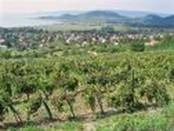The UK is Hungary’s third largest export market with sales increasing at a rapid rate ( over 47% increase in 2009 alone ).
Taken into context Hungarian wine sales are still small in the UK and in fact such is the love of Hungarian wine by the home nationals very little wine ( 70 million litres ) is exported out of the country – just 25% of total production. Over 70% of wine production is white although it has to be said historically full bodied red wines have been the most popular – certainly with the Hungarian people.
In the mid 19th century Hungary was the third largest wine producer in the world with an enviable reputation for quality wines. War and politics changed all that. However, since the end of communism and the eastern bloc in the early 1990’s both vineyard management and oenology have been overhauled and benefitted from increased capital investment resulting in technically sound and extremely good value wines.
Producers have been faced with the dilemma of either growing successful big volume brands such as Sauvignon Blanc and Pinot Grigio styles or sticking with indigenous grapes and terroir. The specialist home produced wines attracting a price premium due to the lower volume produced and the higher marketing costs needed to promote it on the world stage.
As a well known American wine journalist said “ There are really only two kinds of wine, wines that taste as if they came from somewhere, and wines that taste as if they could from anywhere”
Hungary is no exception but it has to be said that for the first time the British public are now seeing the first Hungarian varieties on the supermarket shelves and the indigenous grapes appearing in more and more restaurants.
With limited production capacity restricting export sales until a few years ago the marketing executives of the wine producers now feel confident of spreading the word that Hungarian wine has something to offer and worthy of buying. The major growth will continue to be dry white wine – elegance and acidity rather than tannins. In fact there is a noticeable trend for Hungarian producers to move away from high sugar, over ripe wines which the home market demanded. The most popular being Bordeaux style blends of Villany and the popular Bulls Blood from Eger and Szekszard still attract a price premium when sold overseas.
The key problem facing Hungarian wine producers over the coming years is selling the country – and creating an identity for its’ wine. By and large Hungarian wine remains undiscovered which makes life interesting for the wine taster. There could well be a perfect wine lurking out there that remains undiscovered.
So Hungarian wine producers need to make sure the marketing story is credible, the wine producers are serious and in it for the long term but more importantly the quality of the wine is good and consistent. Tokaj a beautiful sweet wine, is currently the best known of all Hungarian wines but it is dangerous for the whole country to be associated with a single brand otherwise all non Tokaj producers will feel alienated and these producers revert back to satisfying domestic demand – which pre EU membership in 2004 may have worked but with 87 Tesco stores now in Hungary stocking a wide selection of low cost French and Italian wines and shortages no longer an issue this would be a risky strategy.
For this reason Hungarian wine producers are forming marketing associations which aim to improve the reputation of Hungarian wine abroad. An event called “Wines of Hungary” was held in London at the end of April 2009 which showcased nearly 200 wines – this event was the largest ever Hungarian tasting in the UK.
At the event we saw wines from grapes that had been neglected since phylloxera swept through the region in the 19th century. These producers have revived the wine and are achieving very good quality wine from very young vines. Once these vineyards mature the results could be exceptional.
Hungary is now capable of producing fresh, everyday drinking wines at a very competitive price. Those who may have samples Hungarian wine in the past should look again – now is the time to discover wines that are truly refreshing
Isabelle Legeron who now presents her own series ‘Journey into Wine’ for The Travel Channel, a fascinating series of observational documentaries charting Isabelle’s journey around different countries exploring the history and culture of wine. She also regularly makes appearances on UKTV’s Great Food Live, Sky One’s Taste and Destination Lunch as well as appearing on BBC News and Newsnight. Isabella visited Hungary’s wine regions in October 2008 and this was her view of Hungary and its’ wines when interviewed by The Drinks Business.
Basically Isabella was amazed at the array of different flavours and styles of wines available. Hungary’s strength is its’ traditional red wines but with new dynamic young producers has the capability to produce some world class dry wines. The whites are very mineral without being overpowering and the reds have a very vibrant, fresh flavour – “they are great food wines” she commented which should perform well in restaurants.
Hungarian Wine – Did You Know?
- Hungary is the only country in the world where every inch of the land could be used for vine growing.
- Hungary ranks among the top 15 of the 71 wine producing countries in the world according to the size of grape plantations, wine produced, export, and consumption per person. Yet their vineyards are equal in size to only 2 percent of the world’s vineyards.
- Chile, with cultivatable territory similar in size to that of Hungary, spends eight or nine times more money on marketing than Hungary does.
- A book written by a Hungarian serving in the court of the Dutch regent, Maria Habsburg, in 1536 said that “wine is running everywhere in the country.” The rich burghers of the day measured each other’s wealth by how large their vineyards in the Tokaj region were.
- The popular Hungarian wine, Egri Bikavér, or Bull’s Blood, got its name when Turkish troops surrounded Eger castle in 1552, outnumbering by a hundred times the population inside the castle. During the savage attack, red wine was distributed to those fighting on the ramparts, reviving their strength. The Turks, seeing the Hungarians’ red stained shirts, ran away in fear, believing the Hungarians had been drinking bulls’ blood to make them strong.
Tokaj is Hungary’s most famous wine region. Located in the northeast of the country
Around the Lake Balaton area arguably the most scenic part of Hungary and the main tourist area there are several wine growing areas – Badacsony / Balatonboglar / Balatonfelvidek :-
Badacsony (BUH-duh-chun-ye)
Viticulture began here more than 2,000 years ago.
Climate: Balaton Lake moderates temperatures and adds humidity, and sunshine predominates on the sunny southern and south-western slopes.
Soil: Slopes of volcanic hills covered with Pannonian clay, Pannonian sand, and loess, often missed with basalt and basaltic tuff detritus toward the summit.
Best grape varietals: Budai zöld (Buda green), Chardonnay, Furmint, Hárslevelu, Kéknyelu, Nektár, Olaszrizling Muscat Ottonel, Pinot blanc, Rhine Riesling, Riesling Sylvaner, Sauvignon blanc, Szürkebarát (Pinot gris).
Balatonboglár (BUH-luh-tun-bo-glahr)
A flourishing vini- and viticulture was created after the phylloxera disaster when new vines grew well in the Soil and produced excellent wines thanks to expert choice of suitable grape varietals.
Climate: balanced with good sunshine
Soil: hillside, brown forest Soils formed on Pleistocene loess, brown earth and occasionally sand.
Best grape varietals: Chardonnay, Királyleányka, Olaszrizling, Muscat Ottonel, Rhine Riesling, Rizlingszilváni (Riesling Sylvaner), Yellow Muscat, Sauvignon blanc, Szürkebarát (Pinot gris), Tramini, Cabernet franc,
Balatonfelvidék (BUH-luh-tun-fel-vee-dayk)
It is presumed that the Celts grew wine here, and for centuries this region had a reputation for fine wines. The Eszterházy family owned the vineyards here in the 18th century, and made natural dessert wines on their estates.
Climate: Upland, near Balaton Lake, similar to Badacsony but not always as favorable
Soil: Similar to Badacsony, with more variety, including: rendzina, lessivated brown forest Soil, brown earth, chernozem brown forest Soil, and stony earthy skeletal Soil formed on dolomite on top of Pannonian clay, sandstone detritus, loess and Pleistocene sand cover. Triassic limestone, marl, Pannonian sand, and basaltic tuff mixture.
Best grape varietals: Budai zöld, Chardonnay, Cserszegi fuszeres, Furmint, Juhfark, Kéknyelu, Nektár, Pinot blanc, Olaszrizling, Riesling Sylvaner, Sauvignon blanc, Yellow Muscat, Szürkebarát (Pinot gris), Tramini, Zenit, Green Veltliner, Cabernet franc, Cabernet sauvignon, Kékfrankos, Kékoportó, Pinot noir, Zwiegelt.
Why not go and check out the wines for yourselve ?
One festival highly recommended is the annual Wintage festival at Szekszard – normally held around the second / third week of September

